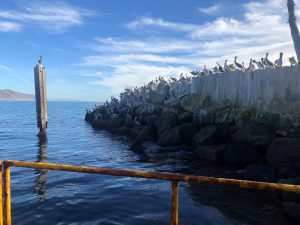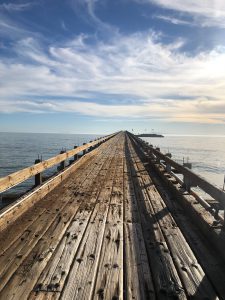
Status
On July 16, staff completed a Final Environmental Impact Report (EIR) for the Rincon Phase 2 Decommissioning Project. The Commission will consider certifying the Final EIR, and if the Final EIR is certified, act on the proposed project at its August public meeting.
Public Meetings
- Draft EIR Meetings 05/02/2024
Video of the 6 p.m. meeting
Video of the 2 p.m. Meeting
Presentation - Public Scoping Meetings 10/20/2022
Video Presentation - Public Meeting 05/04/2022
Video Presentation - Feasibility Study Workshop 06/23/2021
Video of the Workshop
Presentation - Town Hall Meeting 04/07/2021
Video of the Meeting
Driltek Presentation
Padre Associates, Inc. Presentation

Pelicans gathered at Rincon Island, Ventura County. Larger view available.
Background
Until recently, there were three state oil and gas leases associated with Rincon Island, totaling 1,551 acres of tide and submerged lands in Ventura County (map). In 2014, staff identified regulatory violations that posed a significant risk to the marine environment from an uncontrolled release of oil. The Commission, in partnership with the Department of Conservation’s Division of Oil, Gas, and Geothermal Resources, vigorously advocated for the state’s interests before and after Rincon Island Limited Partnership (RILP) filed for bankruptcy in August 2016. On November 29, 2017, the Commission adopted findings and authorized staff to accept a voluntary relinquishment of RILP’s rights in the lease (known as a quitclaim deed) or terminate the leases. On November 30, 2017, the Bankruptcy Court approved a joint motion by the Commission, the chapter 11 trustee, and UBS AG Bank (RILP’s largest secured creditor) to grant the Commission a quitclaim over Rincon Island (Lease No. PRC 1466), which was on December 6, 2017.
The relinquishment means the last operational offshore oil drilling and production facility in the Santa Barbara Channel is over, and RILP’s interests will be added to California’s Coastal Sanctuary. The Commission is now, as it has been, working to ensure public and environmental safety and to protect the state’s public lands and resources.
Previous Staff Reports
- 08/23/2022 (47) – Consider Feasibility Study findings and staff recommendation of Rincon Decommissioning Phase 2 Project and Alternatives to be analyzed in an EIR under CEQA.
- 08/20/2020 (56) – Request authority for the Executive Officer to solicit statements of interest for consultant services, negotiate a fair and reasonable price, and award and execute agreements for a feasibility report and environmental documentation.
- 02/27/2018 (92) – Request authority for the Executive Officer to enter into agreements for access and operations on the former Rincon leases. An update on the Commission’s oil and gas decommissioning projects, including the Becker Well.
- 11/29/2017 (71) – Consider the future disposition of oil and gas leases PRC 1466.1, PRC 410.1, and PRC 145.1, held by Rincon Island Limited Partnership, and proposals submitted on behalf of the bankruptcy estate of Rincon Island Limited Partnership for alternate operators to assume control of those leases.
- 08/17/2017 (77) – An update on Rincon Island Limited Partnership’s operational compliance, chapter 11 bankruptcy proceedings, and a settlement between the Commission and Atlantic Richfield Company, a prior lessee.
Reports and Briefs
Additional Information
- Letter confirming lease quitclaims
12/18/2017 Letter to Rincon Island Limited Partnership (RILP) - The Commission ends offshore oil drilling and production at Rincon Island
12/06/2017 press release regarding lease quitclaims - Letter to Trustee
11/14/2017 Letter to Trustee rejecting the sale of leases and requesting quitclaim - Emergency Order 1114
08/08/2016 CalGEM (DOGGR) Emergency Order issued to RILP - RILP Letter
08/08/2016 CalGEM (DOGGR) Letter to RILP re Emergency Order - Outstanding Violations and Failure to Cure
07/28/2016 Letter to RILP re. outstanding violations and failure to cure - Notice of Default
04/11/2016 Letter to RILP re. Notice of Default
Leases, Agreements, Amendments, & Quitclaims
Lease PRC 145.1 – 05/05/1944
PRC 145.1 Amendment – 06/26/1944
PRC 145.1 Amendment – 08/19/1949
PRC 145.1 Amendment – 04/16/1964
PRC 145.1 Amendment – 08/28/1969
PRC 145.1 Amendment – 03/01/1988
PRC 145.1 Amendment – 11/01/1995
PRC 145.1 Quitclaim – 12/12/2017
Lease PRC 410.1 – 04/17/1949
PRC 410.1 Amendment – 04/17/1959
PRC 410.1 Amendment – 07/01/1974
PRC 410.1 Amendment – 06/01/1985
PRC 410.1 Amendment – 08/01/1986
PRC 410.1 Amendment – 10/01/1987
PRC 410.1 Amendment – 11/01/1987
PRC 410.1 Amendment – 11/01/1995
PRC 410.1 Quitclaim – 12/12/2017
Lease PRC 1466.1 – 08/29/1955
PRC 1466.1 Amendment – 07/28/1958
PRC 1466.1 Amendment – 04/25/1968
PRC 1466.1 Agreement – 10/14/1980
PRC 1466.1 Amendment – 06/01/1985
PRC 1466.1 Amendment – 08/01/1986
PRC 1466.1 Amendment – 10/01/1987
PRC 1466.1 Amendment – 11/01/1987
PRC 1466.1 Amendment – 11/01/1995
PRC 1466.1 Quitclaim – 12/06/2017
Final Rincon Phase 2 Decommissioning
- Final EIR
July 2024 - Feasibility Study
July 2022
Receive Updates
Sign up to receive updates and information on the work being done.
Contact
For inquiries or questions regarding Rincon Onshore and Offshore Facilities, please contact the Rincon Onshore and Offshore Facilities team at Rincon.Phase2@slc.ca.gov.


